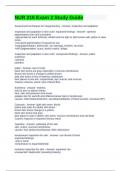NUR 216 Exam 2 Study Guide
Assessment techniques for integumentary - Answer- inspection and palpation
Inspection and palpation in skin color: expected findings - Answer- -general
pigmentation even and consistent
-appropriate for each ethnicity: whitish pink for light or dark brown with yellow or olive
tones
-increased pigmentation if exposed to sun
-hyperpigmentation: birthmarks, sun damage, freckles, tan lines.
-HyPOpigmentation: scars, stretch marks, vitiligo.
Inspection and palpation in skin color: unexpected findings - Answer- pallor
erythema
cyanosis
juandice
pallor - Answer- loss of color
black skin tones are gray especially in mucous membranes.
Brown skin tones a change to yellow-brown.
pale skin tones a loss of redness undertones
best places to see are: conjunctivae, lips, buccal, and mucosa
Causes: Anemia, shock, lack of blood flow
Erythema - Answer- redness
hard to see on darker clients.
face, skin and pressure sore areas.
palpate skin for warmth and inflamed areas hard or tenderness
causes: inflammation/infection, vasodilation(dilation of blood vessels, increases BP)
Cyanosis - Answer- light skin tones: bluish
palms and soles for darker skin tones.
brown skin tones change to a yellow.
black skin tones look grey.
best place to note in darker skin tones: mucous membranes and nail beds
Causes: hypoxia or impaired venous return
Juandice - Answer- yellowing of the skin
skin, sclera, mucosa membranes
causes: liver dysfunction/disease, RBC destruction
temperature inspection for skin - Answer- use dorsal of hand
expected findings:
-skin is warm
-temperature is equal bilaterally
moisture inspection for skin - Answer- expected: dry
unexpected: diaphoretic (sweating heavily)
,texture inspection for skin - Answer- expected: smooth
expected variations: acne, wrinkles, scars
unexpected: velvety skin (thyroid disease) roughness, dryness (xerosis), flakiness
(indicates dehydration)
turgor inspection for skin - Answer- dehydration or normal aging for a "tent"
clavicle location is ideal
edema in skin - Answer- accumulation of fluid in the tissue
-skin i shiny and taut
-most common in legs
-assess over a bony area
-assess in all areas arms, legs and abdomen.
+1 is trace 2mm rapid return
+2 is mild 4mm 10-15 second return
+3 is moderate 6mm prolonged return
+4 is severe 8mm prolonged return
double amount for mm amount
vascular lesions - Answer- results from blood leaking from blood vessels into the
dermis
-Petechiae: infection or trauma.
-Ecchymosis: trauma (collection of blood in dermis >3 mm in diameter, can change
colors during healing (lead).
-purpura: infection or bleeding disorder
note the following for lesions - Answer- color
height (above the skin)
shape
size (measured in cm)
-location and distribution on the body, if any exudate note the color and odor. COCA
(color, odor, consistency, amount)
ABCDEs of melanoma - Answer- A= asymmetry
B= border (irregular)
C= varies (brown, balck, tan)
D= diameter (usually >6mm)
E= evolving (looks different?)
flat lesions: macule - Answer- freckles, mole, measles, scarlet fever
flat lesions: patch - Answer- birthmark, vitiligo, hormonal changes
raised lesions: papule - Answer- wart, elevated mole, skin tags
raised lesions: plaque - Answer- psoriasis, eczema
raised solid lesions: - Answer- tumor (neoplasm)
wheal (inspect bites, allergic reaction, hives
, nodule(melanoma)
raised, fluid lesions (vesicles) - Answer- pustule (acne, cold sore)
cyst: cystic acne, sebaceous cyst
bulla: blister, medication reaction
secondary lesions - Answer- revolve from primary lesions and with time the
characteristics change:
-crust, scaling, ulcers
pressure injuries/ulcers risk factors - Answer- risk factors:
-elderly: thinning skin and less SQ fat
-excessive moisture (urinary issues or fecal)
-shearing and friction
-immobility
-obesity
-poor nutrition and hydration
-vascular disease (lack of circulation)
-sensory deficits
-edema
-chronic disease(DM, liver failure
pressure points for injuries - Answer- Supine:
back of head
shoulder
elbow
butt
heel
Side laying (lateral):
ear
shoulder
elbow
hip
thigh
leg
heel
prone:
elbow
ribcage
thigh
knees
toes
pressure injury: color of wound bed - Answer- red: healthy regeneration
yellow: infection, purulent drainage or slough
black: eschar or necrotic tissue - requires removal for healing
pressure injury: size of wound - Answer- length, width, depth, undermining, tunneling
pressure injury: exudate/drainage - Answer- COCA




